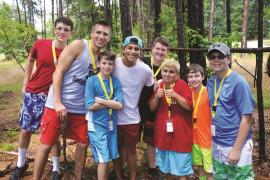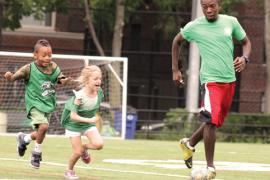Conflicts between kids at camp can arise for a wide variety of reasons — from being upset by relationships with peers or learning to adjust to new and different situations, to being frustrated with their progress in an activity or simply being tired, hot, or hungry — making campers restless, irritable, and/or inattentive. The list of what might trigger conflicts between campers is exhaustive — and can be exhausting!
Depending on their developmental stage, you may be working with campers who are newly learning (not yet mastered) concepts such as sharing, cooperation, making friends, respect for others, communication, emotional control, or taking the view of others — all of which are skills in conflict resolution. Further, in an era of overparenting, many have never had the opportunity to learn how to properly respond to a peer conflict, because an adult has usually stepped in and solved it for them. As such, you need to be prepared to encounter campers who, when faced with conflicts at camp, simply do not have the social skills or experience to navigate these types of interactions.
Conflicts are a normal part of everyone’s life. While there are some proactive steps you can take that may help reduce potential conflicts between campers, it’s unrealistic to expect to prevent every single conflict that might occur at camp. A frequent misconception is that most conflicts will simply resolve themselves over time. The reality is that conflicts are not self-repairing and will not somehow magically improve. Rather, the conflict itself — along with the underlying cause(s) — must be addressed and worked through. As camp staff, you need to be prepared to help campers learn from conflict, use it in a constructive way, and avoid the destructive aspects.
While there is no one “best way” to address conflict, here are some steps to help guide you through the process when working with the campers in your care:
Step ONE: Respond
Whenever conflict arises between campers, it’s important to respond before things escalate or someone is injured.
- Intervene and stop (or redirect) the activity. If a fight breaks out, follow your camp’s policies on separating combatants, follow-up medical care, and incident reporting. (Always follow your camp’s established behavior-management policies and procedures. Ask for help from your supervisor whenever you are unsure of the appropriate action or are unable to deal with a particular camper/situation.)
- Give directions to the campers, telling them nicely but clearly what they need to do.
- As applicable to the situation, give everyone time and space to cool down. Disallow angry verbal exchanges and, if necessary, move combatants away from each other. (Don’t try to communicate with a child who is in a rage. Wait until they are calm and rational to discuss the behavior/incident. Some campers may need help from you to find positive ways to calm down.)
- Once everyone has regained composure, calmly discuss the situation separately with each camper. Listen without being critical to the child’s concerns. You are seeking to understand the issues as well as the underlying causes of the conflict and gain a sense of how best to proceed with resolution.
- Based on the specifics of the situation, campers’ ages, and desired outcomes, move to Step Two — trying one or more resolution activities.
Step TWO: Resolve
The ideal is to help campers learn effective, nonviolent ways to resolve conflict in a manner that they use mistakes as learning opportunities (teachable moments) and are part of (owning) the process. When working with campers through the resolution process, remember there is a difference between teaching and preaching; preaching won’t give children new skills. Try to use the situation to help campers acquire new skills or reinforce one they have already been taught.
Before starting, set ground rules and make sure everyone understands the purpose is to build support, trust, and understanding.
- Keep the environment safe for sharing. For example, campers should respect each other by not laughing, making someone feel dumb for a comment, name calling, etc.
- Keep the focus on dealing with the cause(s)/issue(s) of the conflict, rather than the “personalities.”
- Help campers own and take responsibility for their share of the conflict; reward campers when they take responsibility for their behavior.
- Encourage them to look for ways to correct, improve, and prevent future conflict.
Sample Activities
There is no one-size-fits-all method that will work for every situation. Be sure to consider resolution strategies that are appropriate for the specific incident, as well as being suitable for the ages of the campers involved — giving attention to their emotional maturity, social skills, and previous experience in working through conflict.
Mediation
Sit with the children and help them work it out. The campers involved in the dispute are responsible for finding solutions. Your role is to guide them and keep the process moving, not to solve the problem for them (with the caveat that younger children may need suggestions).
What? So What? Now What?
Frequently used in debriefing team-building activities, the “What? So what? Now what?” model is a simple, effective way to help campers with conflict resolution. Generally sequence your questions by starting with concrete questions then moving into more “insightful” types. Here’s a simple sequence example: “What happened” (define the problem)? “What did you learn” (why does this matter)? “How can you use this information in the future” (develop solutions)?
- The “what” questions focus campers’ thinking on what happened during the conflict. Ask open-ended questions to have campers describe what conflict occurred, such as “What happened when you were playing that game today?”
- Using the responses from the “what” questions, ask “so what” questions so campers will recognize the lessons learned. “So what did you learn from that conflict?”
- Use the “now what” questions to help campers summarize the lessons learned and encourage campers to commit to specific behavior changes. Apply the “so what” learning to other situations – such as making a plan for action to prevent further conflict. This also gives campers a chance to own their solutions. For example, campers might come up with a plan for how to handle any future disagreements about game rules, which they enforce themselves.
In Their Shoes
This activity gives each camper in a two-person conflict a chance to describe their version without interruption from the other, and helps each see the other’s side. Outcomes include learning to listen to the perspective of others, developing empathy, and gaining problem-solving skills. The only supplies required are a couple pairs of oversized shoes/slippers (extra points for giant and silly) or a way to make an impromptu outline of shoes, such as with chalk, stick in the dirt, etc. (For hygienic reasons, please don’t encourage campers to actually wear each other’s shoes.)
Place/draw each pair of shoes on the ground facing each other. Each camper stands in/on “their” pair, facing the other. Camper 1 tells their side of the story, while Camper 2 listens (without comment, argument, eye rolling, etc.). When Camper 1 is finished, have them switch places so they are now standing in the other person’s shoes. Camper 2, who is now standing in Camper 1’s shoes, repeats Camper 1’s story back to them. If Camper 1 is satisfied that Camper 2 “gets it,” have them swap places again, and now it’s Camper 2’s turn to tell their side of the story. Repeat the exercise. (If needed, repeat the process again, so both can clarify what they are saying/hearing.)
When each camper tells their side of the story, they should include the following:
- Their emotions about the conflict: “I feel . . . .”
- What they need to heal, forgive, fix, and so on: “I need . . . .”
- When appropriate, possible solutions: “I think we can resolve this by . . . .”
When each repeats the other camper’s side of the story back to them, they should do the following:
- Restate the other child’s emotions about the conflict: “You feel . . . .”
- Restate what the other needs to heal, forgive, fix, and so on: “You need . . . .”
- Restate possible solutions: “You think we can resolve this by . . . .”
Once it is apparent that each understands the other’s viewpoint, promote discussion about how to come to an agreement and a workable solution. Include the possible solutions provided by the campers.
Note that these are just a few examples of quick conflict-resolution activities. Many books and online resources are available and can be researched as you build your skills toolbox. Your camp may also provide resources, such as a staff library, manuals, and training. An additional list of resources is also included at the end of this article.
Step Three: Restore
A part of children learning how to manage conflict (and some of their own behaviors) includes learning how to reconcile differences and how to repair any harm they may have caused. As such, conflict resolution should focus on solutions that promote repair, reconciliation, and the rebuilding of relationships, rather than being focused on punishment. For children to learn and practice these new behaviors, the ideal whenever possible is:
- Allow for the camper to take responsibility for their action.
- Have the camper make amends.
- Restore the offending camper back into the camp community.
For example, when another person has been harmed, in many instances this is simply a matter of the victim receiving an apology. Or, if a camper has broken or stolen something that belongs to another camper, they may be given the opportunity to repair it or to contact their parents regarding reparation. Restorative resolutions help maintain the critical elements of what makes up an emotionally safe camp environment, and they give campers the opportunity to repair (and learn from) their mistakes and rejoin the group as a whole person. (Again, always follow your camp’s established behavior-management policies and procedures. Some camps require that campers be removed from camp under certain circumstances.)
Step Four: Refocus
Return campers back to activities and refocus on the fun of camp. Move on; there is no need to keep reliving the moment. Allow campers to save face by not broadcasting their “screw-ups” beyond your group; what happens in the cabin stays in the cabin. If a behavior later repeats itself, stop the activity (or talk to the offending camper privately), remind campers of their agreed-upon solutions or preventative strategies, and allow them to take responsibility to implement.
Discussion Questions
|
Diane Tyrrell, CCD, MA Ed, has over 25 years of professional experience working within the camp, youth development, and education fields with for-profit and nonprofit camps and organizations. Diane is the owner and director of Chef Camp, a residential culinary immersion program for teens, and CEO of Frog Pond Consulting, providing integrated solutions to help meet ever-changing marketplace challenges for universities, private schools, camps, recreational facilities, and nonprofit organizations. She can be reached at [email protected].
Additional ResourcesBooks:Adventures in Peacemaking by William J. Kriedler and Lisa Furlong The Big Book of Conflict Resolution Games by Mary Scannell We Can Work It Out by Dr. Barbara Kay Polland Camping Magazine:“Communication Strategies to Create a Positive and Safe Camp Environment,” by Sarah Paver and Zachary Wahl-Alexander, PhD: ACAcamps.org/resource-library/camping-magazine/communication-strategies-create-positive-safe-camp-environment “Let’s Be Friends: A Paradoxical Approach to Bullying Prevention,” by Stephen Gray Wallace, MS Ed: ACAcamps.org/resource-library/camping-magazine/lets-be-friends-paradoxical-approach-bullying-prevention “Collaborative Problem Solving: Cool Hot Tempers and Promote Durable Behavior Change in High-Conflict Situations,” by Christopher Thurber, PhD, ABPP: ACAcamps.org/resource-library/camping-magazine/collaborative-problem-solving-cool-hot-tempers-promote-durable-behavior-change-high Organizations:American Camp Association: ACAcamps.org Peace Education Foundation: peaceeducation.org Engaging Schools: engagingschools.org Health World Education: healthworldeducation.org Overcoming Obstacles: overcomingobstacles.org |


